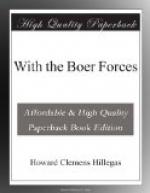Few of the men were given to boasting of the valour they would display in warfare or of their abilities in marksmanship. They had no battle-cry of revenge like “Remember the Maine!” or “Avenge Majuba!” except it was the motto: “For God, Country, and Independence!” which many bore on the bands of their hats and on the stocks of their rifles. Very occasionally one boasted of the superiority of the Boer, and still more rarely would one be heard to set three months as the limit required to conquer the British army. The name of Jameson, the raider, was frequently heard, but always in a manner which might have led one unacquainted with recent Transvaal history to believe that he was a patron-saint of the Republic. It was not a cry of “Remember Jameson” for the wrongs he committed but rather a plea to honour him for having placed the Republic on its guard against the dangers which they believed threatened it from beyond its borders. It was frequently suggested, when his name was mentioned, that after the war a monument should be erected to him because he had given them warning and that they had profited by the warning to the extent that they had armed themselves thoroughly. Seldom was any boasting concerning the number of the enemy that would fall to Boer bullets; instead there was a tone of sorrow when they spoke of the soldiers of the Queen who would die on the field of battle while fighting for a cause concerning the justice or injustice of which the British soldier could not speak.
After the commando-train reached its destination the burghers again took charge of their own horses and conveyances, and in even less time than it required to place them on the train they were unloaded and ready to proceed to the point where the generals needed their assistance. The Boer was always considerate of his horse, and it became a custom to delay for several hours after leaving the train, in order that the animals might feed and recover from the fatigues of the journey before starting out on a trek over the veld. After the horses had been given an opportunity to rest, the order to “upsaddle” came from the commandant, and then the procession, with the ox-waggons in the van, was again formed. The regular army order was then established, scouts were sent ahead to determine the location of the enemy, and the officers for the first time appeared to lead their men in concerted action against the opposing forces. To call the Boer force an army was to add unwarranted elasticity to the word, for it had but one quality in common with such armed forces as Americans or Europeans are accustomed to call by that name. The Boer army fought with guns and gunpowder, but it had no discipline, no drills, no forms, no standards, and not even a roll-call. It was an enlarged edition of the hunting parties which a quarter-century ago went into the Zoutpansberg in search of game—it was a massive aggregation of lion-hunters.




